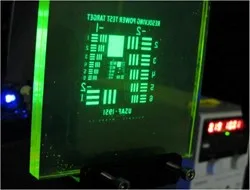A recent prototype demonstrates how, by replacing the phosphor screen in a Laser Phosphor Display (LPD) with a Luminescent Solar Concentrator (LSC), it becomes possible to harvest energy from ambient light as well as display high resolution images.

The prototype was developed by a team lead by Ichiro Fujieda, the head of the Image Information Devices and Materials Laboratory in the School of Science and Engineering at Ritsumeikan University (Japan). A recent article on this subject by the team is entitled “Energy-harvesting laser phosphor display and its design considerations.” It was published in the SPIE’s Journal of Photonics for Energy, 7(2), 028001 (Apr 04, 2017). A copy of the article is available for purchase here.
The LSC consists of a thin phosphor layer sandwiched between two transparent plates. Solar cells are attached to the edge of the plates. When the phosphor layer absorbs light, it generates photoluminescent (PL) photons. Most of the photons propagate within the plates, reach the solar cells and generate power. Some of the photons escape from the surfaces of the plates and display an image.
The prototype developed by the team had a screen that was 95mm × 95mm. The screen was composed of a thin layer of coumarin 6 sandwiched between two acrylic plates. (The organic material coumarin is used as a gain medium for some dye lasers.) The plates guide the PL photons emitted in both directions toward the edges of the plates.
The means by which the image was created started life as a commercial grade DMD-based projector. The projector was modified by removing the existing light source and replacing it with blue laser. After leaving the laser source, the light beam then passed through the balance of the projector optics during which an image was imposed on the light beam.
When the image projected by the projector impinged upon the LSC screen, the screen produced a monochromatic green image. An illustration of the prototype system displaying a test image appears in the figure below.
A resolution test chart image is displayed on the phosphor screen.
Photodiodes covered a 10mm × 10mm region on the edge of the prototype screen to record the power of the PL photons. As the laser was pulsed, the photodiode output was found to vary synchronously. The output of the photodiodes indicated that a configuration in which the photodiodes covered all the edges could harvest up to 71% of the incoming laser power.
In their article, the team commented that a ghost image was noticeable when a high contrast, still image was displayed. The cause of the ghost image was determined to be PL photons reflecting from the interface between the rear plate and the outside environment. It was determined that, by reducing the thickness of the rear plate on the LPD, it was possible to eliminate this artifact.
Comments were offered on the prospects of fabricating a device with a much larger area. The approach discussed was based on tiling multiple modules. To achieve seamless tiling, output couplers were attached to the surface of the transparent plate and served to extract PL photons from each module. This was also found to allow reducing the thickness of the transparent plate needed in a large area system and also to reduce the effect of self-absorption.
In considering applications for the new technology, a team member suggested “Maybe a head-up display for automobiles or goggles for augmented reality, if we can make the phosphor screen more transparent.” The team member went on to point out that “anything of a certain size, from building walls or interior walls to billboards, windshields, etc., can generate power and display moving pictures.”
When asked in what way the technology could impact the design of the next generations of displays, the team member replied that “this innovation may not improve the image quality of current displays but, rather, add a new function.”
Looking towards the future, the team hopes to make the phosphor screen more transparent to extend the range of potential applications. In addition, a color version of the display is clearly of interest although it was acknowledged that such a development might require extensive material research. -Arthur Berman
Ritsumeikan University, Ichiro Fujieda, [email protected]

